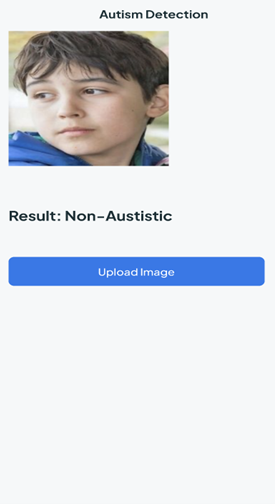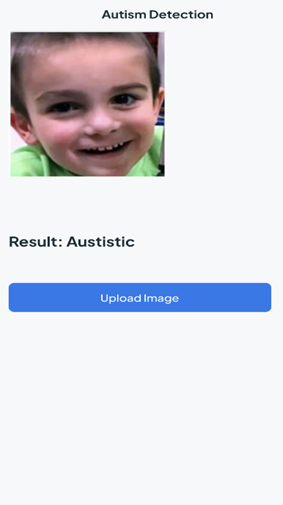Recent News
- Breakthrough in Autism Detection: A New System Patent by CSE Researchers October 14, 2024
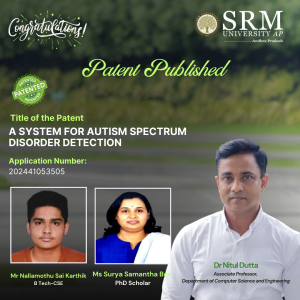 In a significant advancement for neurodevelopmental research, Dr Nitul Dutta, Associate Professor in the Department of Computer Science and Engineering, along with PhD scholar Ms Surya Samantha Beri and BTech student Mr Nallamothu Sai Karthik, have successfully filed and published a patent titled “A System for Autism Spectrum Disorder Detection.” The application, numbered 202441053505, has been officially documented in the Patent Office Journal.
In a significant advancement for neurodevelopmental research, Dr Nitul Dutta, Associate Professor in the Department of Computer Science and Engineering, along with PhD scholar Ms Surya Samantha Beri and BTech student Mr Nallamothu Sai Karthik, have successfully filed and published a patent titled “A System for Autism Spectrum Disorder Detection.” The application, numbered 202441053505, has been officially documented in the Patent Office Journal.The innovative system aims to enhance the early detection of Autism Spectrum Disorder (ASD), providing a more efficient and accessible method for diagnosis. By integrating advanced algorithms and machine learning techniques, the system promises to analyse behavioural data effectively, allowing for timely interventions and support for individuals on the spectrum. Dr Dutta emphasised the importance of early detection, stating, “The earlier we can identify ASD, the better the outcomes for individuals and their families. Our system is designed to make this process more accurate and user-friendly.”
Ms Beri and Mr Karthik contributed significantly to the research, which reflects a collaborative effort between academia and technology. Their work not only demonstrates the potential for technological solutions in healthcare but also highlights the critical role of interdisciplinary approaches in addressing complex challenges.
This patent represents a crucial step forward in the field of autism research and is expected to pave the way for further innovations aimed at improving the lives of those affected by ASD.
Abstract of the Research
The system for autism spectrum disease detection incorporates a server with a hybrid application comprising several key modules: a capturing module receiving images from image-capturing devices , a data collection module gathering a dataset of images from multiple capturing devices, and a pre-processing module standardising and normalising images to generate a standardised dataset. Additionally, a feature extraction module collaborates with the pre-processing module to identify autism-indicative features in standardised images, preparing labelled standardised images stored in the data collection module.
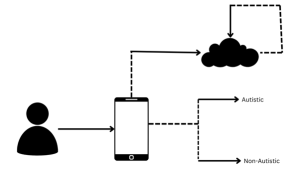
Furthermore, a data segmentation module segments standardised images into training and testing data, including a training module for real-time training of a convolutional neural network model and a testing module to evaluate the convolutional neural network model’s accuracy in detecting autism based on testing data.
Explanation of the Research in Layperson’s Terms
The background information herein below relates to the present disclosure but is not necessarily prior art. Autism spectrum disorder (ASD) is a neurological or developmental disorder that profoundly impacts communication skills, social interaction, and cognitive abilities in individuals. Those with Autism Spectrum Disorder (ASD) often exhibit challenges in social interaction, limited eye contact, difficulty understanding social cues, and impaired language skills. Additionally, repetitive behaviours and sensory sensitivities are common characteristics.
The disorder arises from developmental changes in brain structure and can have various causes, including genetic factors, familial history of autism spectrum disorder (ASD), advanced parental age, or low birth weight. The prevalence of autism spectrum disorder (ASD), as reported by the World Health Organization (WHO), stands at one in every 160 children. Early detection and intervention are crucial for managing autism spectrum disorder (ASD) effectively, as interventions such as medical and neurological examinations, cognitive and language assessments, and frequent observations, including blood and hearing tests, can significantly improve outcomes. Detecting Autism Spectrum Disorder (ASD) in children below the age of 10 is comparatively easier than in adults, underscoring the importance of early diagnosis to facilitate timely interventions.
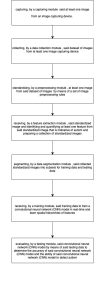
Current diagnostic processes for autism spectrum disorder (ASD) often present significant challenges, particularly for young children, due to their limited ability to communicate and cooperate during assessments. Traditional diagnostic methods rely heavily on structured interviews, behavioural observations, and standardised tests, which can be daunting and stressful for children, leading to inaccurate results. Moreover, these procedures are time-consuming and often require multiple visits to specialised clinics or healthcare facilities, causing inconvenience and financial strain for families. Also, the cost associated with autism spectrum disorder (ASD) diagnosis can be prohibitive for many families.
Therefore, there is a pressing need for more accessible, less intrusive, and cost-effective methods for detecting autism spectrum disorder (ASD) in its early stages to ensure timely and effective intervention. Therefore, there is a need for a system for autism spectrum disorder detection that alleviates the drawbacks.
Practical and Social Implications Associated with the Research
Current diagnostic procedures for Autism Spectrum Disorder (ASD) face considerable technical challenges, particularly concerning young children’s limited ability to engage in conventional assessment methods. These methods typically rely on structured interviews, behavioural observations, and standardised tests, all of which can be arduous and distressing for children with Autism Spectrum Disorder (ASD), potentially leading to unreliable outcomes. Furthermore, these procedures are resource-intensive, requiring multiple visits to specialised clinics or healthcare facilities, thereby causing logistical challenges and financial burdens for families. Current diagnostic processes for Autism Spectrum Disorder (ASD) often present significant challenges, particularly for young children, due to their limited ability to communicate and cooperate during assessments. Traditional diagnostic methods rely heavily on structured interviews, behavioural observations, and standardised tests, which can be daunting and stressful for children, leading to inaccurate results. Moreover, these procedures are time-consuming and often require multiple visits to specialised clinics or healthcare facilities, causing inconvenience and financial strain for families. Also, the cost associated with Autism Spectrum Disorder (ASD) diagnosis can be prohibitive for many families. Therefore, there is a pressing need for more accessible, less intrusive, and cost-effective methods for detecting Autism Spectrum Disorder (ASD) in its early stages to ensure timely and effective intervention.
Collaborations
This research was done in collaboration with Professor George, Brunel University, London, United Kingdom
Future Research Plans
In the future, we will also try to diagnose the disorder by speech therapy using Natural Language Processing and integrate it with real-time industry in health care, which can be used by many doctors in their respective practices
Continue reading → - Patent Filed for Innovative Load Balancing System in Cloud Computing October 8, 2024
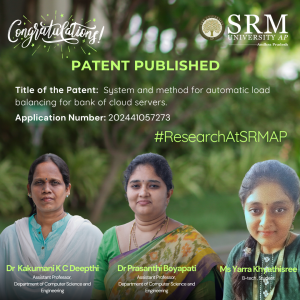 In a significant advancement for cloud computing technologies, Dr Kakumani K C Deepthi and Dr Prasanthi Boyapati, Assistant Professors in the Department of Computer Science and Engineering, alongside B Tech student Ms Yarra Khyathisree, have successfully filed and published a patent titled “SYSTEM AND METHOD FOR AUTOMATIC LOAD BALANCING FOR BANK OF CLOUD SERVERS.” The patent, registered with Application Number 202441057273, was officially published in the Patent Office Journal.
In a significant advancement for cloud computing technologies, Dr Kakumani K C Deepthi and Dr Prasanthi Boyapati, Assistant Professors in the Department of Computer Science and Engineering, alongside B Tech student Ms Yarra Khyathisree, have successfully filed and published a patent titled “SYSTEM AND METHOD FOR AUTOMATIC LOAD BALANCING FOR BANK OF CLOUD SERVERS.” The patent, registered with Application Number 202441057273, was officially published in the Patent Office Journal.As cloud computing continues to expand, effective load balancing has become critical for optimizing distributed environments. Load balancing is essential for distributing data and services across a scalable network of nodes, ensuring that no single node becomes overwhelmed. This is particularly important as data storage needs in cloud environments grow exponentially.
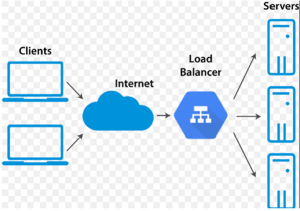
The newly patented system aims to enhance load balancing and job scheduling, addressing the increasing demand for efficient services. The article highlights various notification algorithms designed to improve these processes, comparing the latest methods to boost performance and user satisfaction.
This innovation marks a promising step forward in cloud computing technology, paving the way for more robust and efficient systems to meet the evolving needs of users and organizations alike.Abstract of the Research
Load balancing is crucial for the efficient operation of distributed environments, especially with the rapid growth of cloud computing and increasing customer demands for more services and positive outcomes. Cloud load balancing involves transparently sharing data and delivering services through a scalable network of nodes. Due to the open and distributed nature of cloud computing, the amount of data storage grows rapidly, making load balancing a critical issue. Managing load information in such a vast system is costly. A major challenge in cloud computing is distributing dynamic workloads across multiple nodes to prevent any single node from becoming overwhelmed. Numerous algorithms have been proposed to effectively allocate customer requests to available cloud nodes. These methods aim to enhance the overall performance of the cloud and provide users with more satisfying and efficient services. This article reviews various notification algorithms to address cloud computing load balancing and job scheduling issues, comparing the latest methods in the field.
Practical Implementation or the Social Implications Associated with the Research
In this patent, the common load-balancing algorithms in cloud computing include:
• Round Robin
• Least Connection
• Randomized
• Load Balancing Challenges in Cloud Computing
• Automated Service Provisioning
• Virtual Machine Migration
• Energy Management
• Stored Data ManagementFuture Research Plans
To implement automatic load balancing for not only banks but also some other applications where cloud servers can be designed by ensuring optimal resource utilization, performance, and reliability.
Continue reading →


